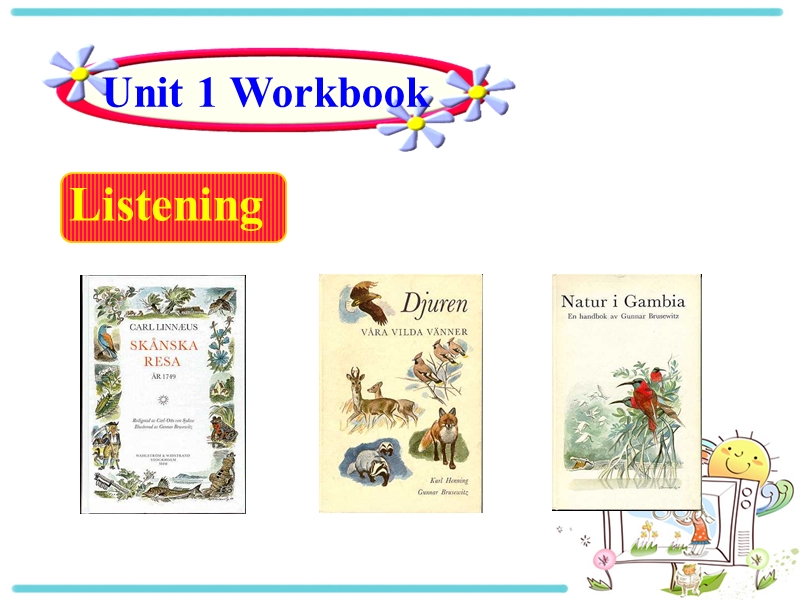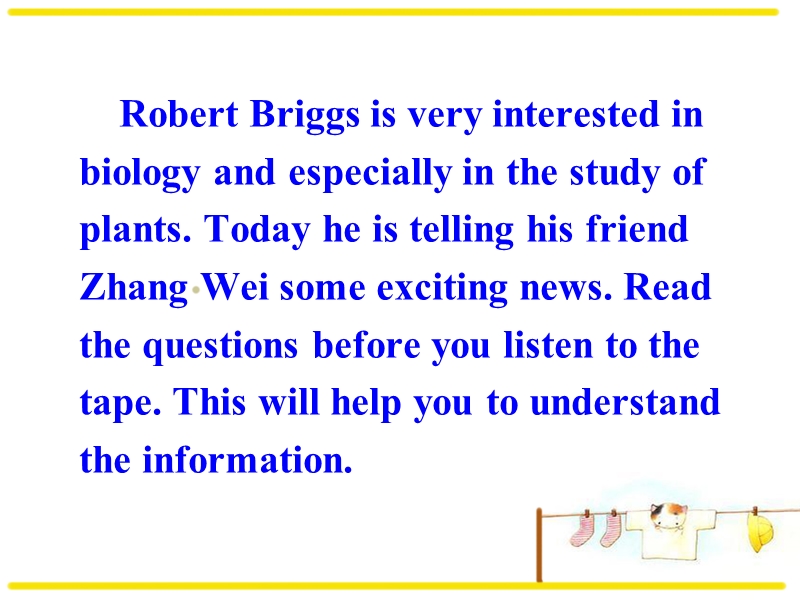 人教新课标高中英语必修5《Unit1 Workbook》课件
人教新课标高中英语必修5《Unit1 Workbook》课件
《人教新课标高中英语必修5《Unit1 Workbook》课件》由会员分享,可在线阅读,更多相关《人教新课标高中英语必修5《Unit1 Workbook》课件(75页珍藏版)》请在七七文库上搜索。
1、Unit 1 Workbook,Robert Briggs is very interested in biology and especially in the study of plants. Today he is telling his friend Zhang Wei some exciting news. Read the questions before you listen to the tape. This will help you to understand the information.,1 Before you listen to the tape discuss
2、with your partner how you would find out the name of a flower.,New words in the listening passage:species (种类),parrot (鹦鹉),blackbird (画眉类)黑鸟,This is about a man who wants to name a flower. This is about a man who finds a flower and wants to own it. This is about a man who finds a flower and wants to
3、 know if it is a new species of flower.,Listen to the tape once and tell what this listening passage is about.,To find the name of an unknown flower, first you should ask your _ teacher to help you. He / She will look in a special _written by Carl Linnaeus.,biology,book,Listen to the tape again and
4、try to complete the following passage.,He lived in _ from _ to _ . He was very important because he solved a _ problem for biology.,Sweden,1707,1778,serious,Listen to the tape again and answer these questions.,1 If Robert Briggs find the flower in the book, what does that mean? 2 How would he know i
5、f his lily is a new species? 3 Why do plants all have two names? 4 What was the serious problem for biology that Linnaeus solved?,1 If Robert Briggs finds the flower in the book, what does that mean?,It means that his flower has already been identified and has a name.,2 How would he knows if his lil
6、y is a new species?,He would know by checking his lily against other lilies in the specialist book. If his lily is different it will be a new species.,3 Why do plants all have two names?,All plants have two names just like people. The first is the group of flowersthey belong to and is like the famil
7、y name. The second is the kind of flower within that group and is like a given / personal name.,4 What was the serious problem for biology that Linnaeus solved?,Before Linnaeus there was no way of finding out whether a plant was new or not. This causes problems because different scientists claimed t
8、hat they had found and named flowers first. After he organized his system it was easy to discover whether a plant was new or not and so who had the right to name it.,NAMING A FLOWER Robert Briggs (RB) is talking to Zhang Wei (ZW) about a new kind of lily he has found.,Listening text,ZW: Hello Robert
9、. Whats that book youre carrying? RB: A book that helps you identify a flower. ZW: I see. Why do you want that? RB: Ive found this lily. It looks differentto me. So I want to find out if its new or not. Our biology teacher toldme that if its already known, Id find it in this book.,ZW: Wow! So you th
10、ink you may have found a new lily? RB: I hope so, but I have to do some research first to find out for sure. ZW: What happens if its in the book? RB: It means that somebody else has found it and named it. Then Ill know its biological name. ZW: What do you mean by the biological name?,RB: Actually li
11、ke us a flower has two names. The first is the group of flowers it belongs to like a family name. A rose is one such group. The second is the kind of flower like a given name. It may describe what therose looks like; for example, the colour of an autumn sunset. Togetheryou get the flowers name, whic
12、h Rose Autumn Sunset.,ZW: Gosh! Who made that system? RB: A great scientist called Carl Linnaeus. He lived in Sweden from 1707 to 1778. ZW: So long ago! RB: Yes, and he solved a very seriousproblem for biology. ZW: What was that?,RB: Before him nobody could tell if a plant was new, as there was no w
13、ay of checking. Therere so many plants, you see! ZW: Yes, I appreciate that! So his system is still used? RB: Indeed it is. If my flower isnt in this book, Ill know that Ive founda new kind of lily.,ZW: Thats great! Can I come and help you? This research sounds fun. RB: Yes, and if Im lucky (fading
14、out),1 This is a report on living conditions in England in the nineteenth century. Choose the proper words in its correct form to put into the text.,instruct neighborhood pollute defeat handle suspect blame severe clue link . to draw the conclusion cure,Educated people in the twenty-first century ma
15、y find it hard to believe that two hundred years ago people did not _ illness _ problems in the environment. We all know that in London drinking _ water caused,link,to,polluted,many deaths from cholera. There was a _ to its cause because it always started in the poor _. Then it spread to the richer
16、areas as the servants passed it on. Many doctors _ that polluted water was to _ and clean water was the _.,clue,neighbourhood,suspected,blame,cure,John Snows investigation proved that the dirtier the water, the more _ the illness. So the government and the doctors _ that water must be purified. They
17、 _ people to remove the _ from the pumps if the water was infected. Thus cholera was _ in the end.,instructed,drew the conclusion,severe,handles,defeated,Answer key for Exercise 2 on page 42,1 2 5 6 3 4 1,3 Translate these sentences into English, using the words and phrases in brackets.,1. 除了去公园以外,这
18、个夏天我就没有出过公寓。(apart from),Apart from going to the park, I limit my movements to my neighbourhood.,2. 没有足够的证据很难作出结论。(make a conclusion),It is difficult to draw a conclusion without enough evidence.,3. 这些科学实验的结果对于我们非常有 价值, 它们将有助于我们的研究取得成 功。(scientific enquiry; contribute to),These scientific enquires w
19、ill contribute to the success of our project.,4. 居斯特夫埃菲尔对他修建铁塔的计划满怀热情, 而这座塔使他闻名于世。 (Gustave Eiffel; enthusiastic; construct),Gustave Eiffel was very enthusiastic about his plan to construct the iron tower, which made him world-famous.,5. 他常提出些不同寻常的计划。你在加入之前要慎重对待。( put forward; be cautious to; join i
20、n),He often puts forward unusual plans. So be cautious about them before you decide to join in.,6. 谁是第一个反对“地心说”的人?(reject; universe),Who was the first person to reject the idea that the earth was the centre of the universe?,7. 虽然他的写作没什么意思,但弗雷德还是确信自己的作文会得高分。( make sense; positive),Although his writin
21、g doesnt make sense, Fred is positive that his composition will score a high mark.,1 Choose appropriate verbs to complete the following sentences, using the past participle. Explain the use of the past participle in each sentence.,1. They were _ to accept my idea. 2. Ill be _ to hear what he has to
22、say. 3. The mayor said that he was _about the _ rise of the water level in the river bed.,prepared,interested,worried,continued,4. Recently _ soldiers are helping to take the victims to safe areas from the flood. 5. Most of the newspaper seems to be _ with pop stars. 6. He was _ of going alone into
23、the empty house.,arrived,concerned,frightened,2 Rewrite these sentences as one sentence using the past participle as the attribute or predicative.,1. I found this plate on the floor. The plate was broken in pieces.I found this broken plate on the floor.,2. I saw a tall, dark and handsome man. His na



- 配套讲稿:
如PPT文件的首页显示word图标,表示该PPT已包含配套word讲稿。双击word图标可打开word文档。
- 特殊限制:
部分文档作品中含有的国旗、国徽等图片,仅作为作品整体效果示例展示,禁止商用。设计者仅对作品中独创性部分享有著作权。
- 关 键 词:
- 新课 标高 英语 必修 Unit1Workbook 课件
 七七文库所有资源均是用户自行上传分享,仅供网友学习交流,未经上传用户书面授权,请勿作他用。
七七文库所有资源均是用户自行上传分享,仅供网友学习交流,未经上传用户书面授权,请勿作他用。
文档标签
- 英语新课改版
- 人教新课标高中英语必修5Unit1 Warming up课件
- 2019年人教新课标高考一轮复习必修四Unit1课件
- 2019年人教新课标高考一轮复习必修五Unit1课件
- 2019年人教新课标高考一轮复习选秀六Unit1课件
- 天利2021新课标
- 新课标闯关卷
- 2021英语学年新课标闯关卷18初三
- 人教新课标高中英语必修5Unit4 Workbook课件
- 人教新课标高中英语必修5Unit5 Workbook课件
- 人教新课标高中英语必修2Unit5 Workbook课件
- 人教新课标高中英语必修2Unit2 Workbook课件
- 人教新课标高中英语必修5Unit3 Workbook课件
- 人教新课标高中英语必修2Unit4 Workbook课件
- 人教新课标高中英语必修2Unit3 Workbook课件
- 人教新课标高中英语必修5Unit1 Workbook课件
- 人教新课标高中英语必修5Unit1 Reading课件
- 人教新课标高中英语选修六Unit1 Workbook课件
- 人教新课标高中英语必修1Unit4 Workbook课件



 浙公网安备33030202001339号
浙公网安备33030202001339号
链接地址:https://www.77wenku.com/p-39952.html